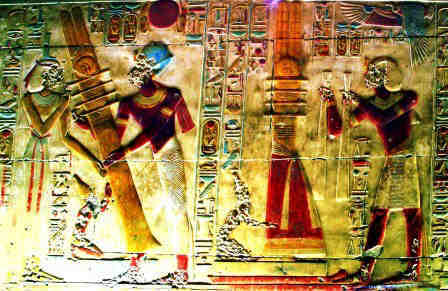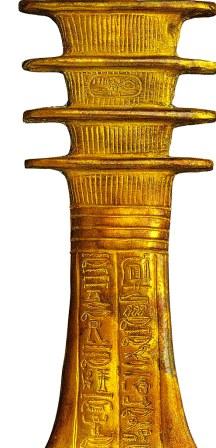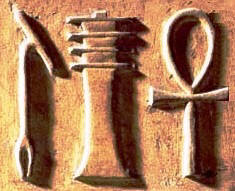
| The Djed | 
|
|
Ancient Egyptian Gods and Goddesses for kids - Djed The history of ancient Egypt and the significance of the Djed pillar in hieroglyphs |
|
Djed
Discover the history and religious beliefs surrounding the 'Djed Pillar', symbolized by a tree trunk, which features in many images, Hieroglyphics, pictures and amulets found in ancient Egypt. The Djed pillar, or column, derives its name from the cult of Osiris which was based in the city of Djedet in the in the eastern Nile delta. Osiris, the god of death, was worshipped as the "Ba of the Lord of Djedet". It was identified as the 'symbolic backbone of Osiris'. The Djed pillar resembled the shape of a small tree trunk, representing stability and endurance. An important ritual called 'Raising the Djed Pillar' took place at the ceremony of the coronation of Egyptian Pharaohs. Djed amulets were placed on a mummy to ensure that the deceased were reborn in the Afterlife. |
|
Facts about the Egyptian Djed
The Djed was an ancient Egyptian hieroglyph and its icon is depicted in art, artefacts, relics. Examples of the icon can be found in the tombs, temples and manuscripts of the ancient Egyptians. The following picture depicts a hieroglyph of the 'Raising the Djed Pillar' ceremony as performed by the Pharaoh Seti in the presence of the goddess Isis. The djed pillar was a phallic symbol symbolising the "potency and duration of the pharaoh's rule". The second picture shows a golden Djed amulet which was found in the tomb, around the neck, of Tutankhamen. The type of amulet was one of the most common of all talismans placed on a mummy. Several could be strung around the lower torso, or one was placed on the upper chest or around the neck.

| 
| | Seti raising a Djed Pillar to Isis - hieroglyphs at Abydos | A golden Djed amulet |
Djed Fact File |
Name: |
The name derives from "Ba of the Lord of Djedet"
| | Description & Definition: | Description & Definition: It was the shape of a curved pillar, or column, with a broad base and capital (top of the column) is divided by four parallel bars. A similar shape to a tree trunk, and possibly related to the Tree of Life, the fruit of which was given by the gods to provide divine nourishment
| | Application / Use: | The symbol and distinctive 'tree trunk' shape was used as:- Amulets
- In ceremonies in which the ritual of 'Raising a Djed Pillar' was re-enacted to commemorate the death and resurrection of Osiris. The symbol represented the building-up of the backbone and reconstruction of the body of Osiris.
- Actual Pillars as depicted in hieroglyphs
| | Materials: | The materials used to make the symbol varied according to their use but could be constructed from stone, wood, ebony, ivory or precious metals such as gold
| | Significance: | The sacred amulet was placed on a mummy to ensure that the deceased were reborn and endured in the Afterlife.
| | Symbol: | It was was one of the most potent symbols of ancient Egypt symbolizing stability and endurance
| | Fetish: | The Djed was believed to be a fetish, an object that was believed to embody magical powers and offer magical protection. It had the power to enhance endurance and stability of:- People
- Institutions, like the kingship of the Pharaoh
- Actual physical structures - Djed symbols engraved on columns were believed to improve the stability of the building
|
|
|
Ancient Egyptian Symbols - The Djed
The Djed is one of the three most important ancient Egyptian Symbols, the other notable symbols are the Was Sceptre and the Ankh. | 
Ancient Egyptian symbols: Was Sceptre, the Djed and the Ankh The Djed - Symbol of Stability and Endurance
The Djed was a symbol of stability and endurance and was an icon depicted in ancient Egyptian funeral scenes and those depicting the Underworld. It is commonly displayed in association with the Was Sceptre and the Ankh. - The Was Sceptre: The Was Sceptre was a long thick staff, resembling a small tree trunk,that symbolized divine power and was an emblem of authority
- The Ankh: The symbolized physical life, eternal life, immortality and reincarnation
|
|
|
Djed- Interesting research information and Facts about the Egyptian symbol of stability and endurance
- The sacred symbol of ancient Egyptians
- History and Egyptian Mythology associated with the Egyptian symbol of stability and endurance
- Facts and information about the gods and deities of of classical Egypt for schools, research and kids
- Pictures, Description and definition of the Djed for kids
|
| | |
|
Facts about the Djed in Egyptian Mythology and History
Discover interesting information and research facts about this iconic Egyptian symbol. The facts about the Djed provides a list detailing fascinating additional info to increase your knowledge about the Djed in Egyptian Mythology and history. Facts about the Djed from Mythology and Egyptian History |
Fact 1: |
According to the instructions in the Book of the Dead, the Djed amulet should be made of gold and be placed on the neck of the deceased on the day of his funeral
| | Fact 2: | Spells were inscribed on the amulets to ward off the dangers of the Underworld
| | Fact 3: | Words for Osiris were included in the Book of the Dead were engraved on one of two Djed amulets found on the mummy of Tutankhamen. The words are: "Thou hast thy backbone, O weary one of heart; thou shalt place thyself upon thy side so that I may give thee water beneath thee. I have brought thee a djed pillar of gold; mayest thou be please with it."
| | Fact 4: | It was later associated with the creation god Ptah who was called the "Noble Djed".
| | Fact 5: | During the 'Raising the Djed Pillar' ceremony, which took place at Memphis, the pharaoh himself, supported by priests, raised the pillar with the help of ropes and could be a symbolic representation of raising the Tree of Life. The ceremony emphasised the stability of the pharaoh, and symbolized the rebirth of Osiris. It was also part of the Heb-Sed, the rejuvenation ceremony which was generally performed by aging pharaohs ensuring their powers were to restored
| | Fact 6: | According the ancient Egyptian mythology Osiris was imprisoned by Set in a tree which became a pillar in a king’s palace. The tree symbolized the Tree of Life
| | Fact 7: | The symbol was also connected with fertility and conserved the fruitfulness of the grain
| | Fact 8: | Modern theorists say that the Djed represents electricity, a power generator or a medium to control the weather.
| Facts about the Djed from Mythology and Egyptian History |
|
|
|
|